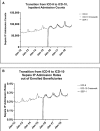Sepsis Among Medicare Beneficiaries: 1. The Burdens of Sepsis, 2012-2018
- PMID: 32058366
- PMCID: PMC7017943
- DOI: 10.1097/CCM.0000000000004224
Sepsis Among Medicare Beneficiaries: 1. The Burdens of Sepsis, 2012-2018
Abstract
Objectives: To provide contemporary estimates of the burdens (costs and mortality) associated with acute inpatient Medicare beneficiary admissions for sepsis.
Design: Analysis of paid Medicare claims via the Centers for Medicare & Medicaid Services DataLink Project.
Setting: All U.S. acute care hospitals, excluding federally operated hospitals (Veterans Administration and Defense Health Agency).
Patients: All Medicare beneficiaries, 2012-2018, with an inpatient admission including one or more explicit sepsis codes.
Interventions: None.
Measurements and main results: Total inpatient hospital and skilled nursing facility admission counts, costs, and mortality over time. From calendar year (CY)2012-CY2018, the total number of Medicare Part A/B (fee-for-service) beneficiaries with an inpatient hospital admission associated with an explicit sepsis code rose from 811,644 to 1,136,889. The total cost of inpatient hospital admission including an explicit sepsis code for those beneficiaries in those calendar years rose from $17,792,657,303 to $22,439,794,212. The total cost of skilled nursing facility care in the 90 days subsequent to an inpatient hospital discharge that included an explicit sepsis code for Medicare Part A/B rose from $3,931,616,160 to $5,623,862,486 over that same interval. Precise costs are not available for Medicare Part C (Medicare Advantage) patients. Using available federal data sources, we estimated the aggregate cost of inpatient admissions and skilled nursing facility admissions for Medicare Advantage patients to have risen from $6.0 to $13.4 billion over the CY2012-CY2018 interval. Combining data for fee-for-service beneficiaries and estimates for Medicare Advantage beneficiaries, we estimate the total inpatient admission sepsis cost and any subsequent skilled nursing facility admission for all (fee-for-service and Medicare Advantage) Medicare patients to have risen from $27.7 to $41.5 billion. Contemporary 6-month mortality rates for Medicare fee-for-service beneficiaries with a sepsis inpatient admission remain high: for septic shock, approximately 60%; for severe sepsis, approximately 36%; for sepsis attributed to a specific organism, approximately 31%; and for unspecified sepsis, approximately 27%.
Conclusion: Sepsis remains common, costly to treat, and presages significant mortality for Medicare beneficiaries.
Figures








Comment in
-
The Eye-Popping Costs Associated With Sepsis Diagnoses Among Medicare Beneficiaries.Crit Care Med. 2020 Mar;48(3):420-422. doi: 10.1097/CCM.0000000000004228. Crit Care Med. 2020. PMID: 32058376 Free PMC article. No abstract available.
References
-
- Tillmann B, Wunsch H. Epidemiology and outcomes. Crit Care Clin 2018; 34:15–27 - PubMed
-
- National Center for Emerging and Zoonotic Infectious Diseases (NCEZID), Centers for Disease Control and Prevention, Division of Healthcare Quality Promotion (DHQP) CDC Data and Reports, 2016. Cited August 23, 2016. Available at: https://www.cdc.gov/sepsis/datareports/index.htmlAccessed August 23, 2016.
-
- Torio CM, Moore BJ. National Inpatient Hospital Costs: The Most Expensive Conditions by Payer, 2013: Statistical Brief #204. Healthcare Cost and Utilization Project (HCUP) Statistical Briefs. 2006Rockville, MD, Agency for Healthcare Research and Quality. - PubMed

